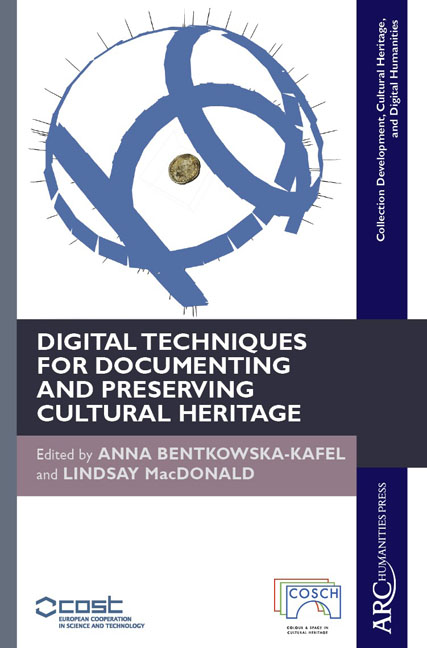Hyperspectral Imaging
Published online by Cambridge University Press: 26 January 2021
Summary
COSCH Case Study that has employed this technology: Round Robin Test (chapter 8)
Definition
Hyperspectral imaging is the acquisition and processing of images of an object or scene in a hundred or more wavelength bands, typically spanning the visible and near infrared spectrum. The fine spectral resolution enables the identification of features and characterization of materials that would not be possible with systems which have fewer channels of broader responsivity.
Description
Hyperspectral imaging techniques are used in many scientific and industrial applications, both indoor and outdoor. Hyperspectral line-scanners have some limitations when the subject is moving or rapid measurement is needed or long-time illumination is not appropriate. To overcome these limitations a novel technique with increased light efficiency was developed with a non-scanning principle, which is called snapshot hyperspectral imaging or spectral frame camera technique. It enables the acquisition of the entire hyperspectral image during a single integration time (one shot takes about 1 ms). The latest snapshot hyperspectral imaging devices provide a rapid, high-quality and easy-to-use data acquisition for spectral object documentation.
Diffuse reflectance spectroscopy in the visible (VIS) and near-infrared (NIR) regions has been widely used in both the laboratory and in situ spectral measurement. Non-imaging spectroradiometers provide the highest available spectral resolution and therefore high information content for estimating material properties with multivariate methods. However, only measurements integrated over a single sampling region, determined by the aperture of the instrument, can be performed, which makes it difficult to analyse spatial variability. In contrast, a spectral imaging system captures both the spatial variability and spectral content at each point of the scene.
Hyperspectral imaging has undergone considerable changes regarding data access, usability, and technology. When looking at the four dimensions (spectral, radiometric, temporal, and spatial) of proximal and remote sensing, the temporal resolution is in greatest need of improvement. Regarding usability and flexibility a snapshot (non-scanning) hyperspectral camera behaves like a normal digital camera, while the imaging result is a stack of component images corresponding to the line-scanner's data cube. Hagen et al. (2012) gives a detailed overview on how snapshot systems work and have been developed. Figure 16.1 shows the main differences and similarities between the three types of spectral imaging systems. Snapshot spectral cameras provide high-resolution spectro-temporal data and meet the general demand for high quality and easy to access hyperspectral data.
- Type
- Chapter
- Information
- Publisher: Amsterdam University PressPrint publication year: 2018



